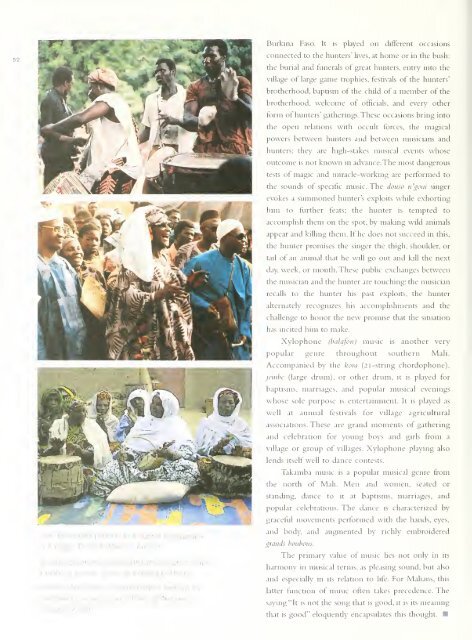SCOTLAND - Smithsonian Digital Repository - Smithsonian Institution
SCOTLAND - Smithsonian Digital Repository - Smithsonian Institution
SCOTLAND - Smithsonian Digital Repository - Smithsonian Institution
You also want an ePaper? Increase the reach of your titles
YUMPU automatically turns print PDFs into web optimized ePapers that Google loves.
Burkina Faso. It is played on different occasions<br />
connected to the hunters' lives, at home or in the bush:<br />
the buna! and flmerals of great hunters, entry into the<br />
village of large game trophies, festivals of the hunters'<br />
brotherhood, baptism of the child of a member of the<br />
brotherhood, welcome of ofEcials, and every other<br />
form of hunters' gatherings. These occasions bring into<br />
the open relations with occult forces, the magical<br />
powers between hunters and between musicians and<br />
hunters; they are high-stakes musical events whose<br />
outcome is not known in advance. The most dangerous<br />
tests<br />
of magic and miracle-working are performed to<br />
the sounds of specific music. The donso n'goni singer<br />
evokes a<br />
summoned hunter's exploits while exhorting<br />
him to further feats; the hunter is tempted to<br />
accomplish them on the spot, by making wild animals<br />
appear and killing them. If he does not succeed in this,<br />
the hunter promises the singer the thigh, shoulder, or<br />
tail<br />
of an animal that he wiO go out and kiO the next<br />
day, week, or month. These pubhc exchanges between<br />
the musician and the hunter are touching: the musician<br />
recalls to the hunter his past exploits, the hunter<br />
alternately recognizes his accomplishments and the<br />
challenge to honor the new promise that the situation<br />
has incited him to make.<br />
Xylophone (biilafoii) music is another very<br />
popular genre throughout southern Mali.<br />
Accompanied by the koni (21 -string chordophone),<br />
jcnibe (large drum), or other drum, it is played for<br />
baptisms, marriages, and popular musical evenings<br />
whose sole purpose is entertainment. It is played as<br />
well at annual festivals for village agricultural<br />
associations. These are<br />
grand moments of gathering<br />
and celebration tor young boys and girls from a<br />
village<br />
or group of villages. Xylophone playing also<br />
lends itself well to dance contests.<br />
Takamba music is a popular musical genre from<br />
the north of Mali. Men and women, seated or<br />
standing, dance to it at baptisms, marriages, and<br />
popular celebrations. The dance is characterized by<br />
graceful<br />
movements pertbrmed with the hands, eyes,<br />
(Top) Drummers perform at a puppet masquerade<br />
in Kirango. Photo © Mary Jo Arnoldi<br />
(Middle) Siramori, a celebrated woman gnot, sings<br />
a patron's praises. Photo © Barbara Hoffman<br />
(Bottom) Musicians in northern Mali perform on<br />
the bowed lute and drums. Photo © National<br />
Museum of<br />
Mali<br />
and body, and augmented by richly embroidered<br />
grands boubotis.<br />
The primary value of music lies not only in its<br />
harmony in musical terms, as pleasing sound, but also<br />
and especially in its relation to lite. For Malians, this<br />
latter function of music often takes precedence. The<br />
saying "It is not the song that is good, it is its meaning<br />
that is good" eloquently encapsulates this thought.
















